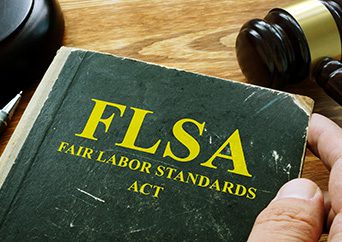The classification of workers has direct implications on their eligibility for benefits, legal protections (such as minimum wage and overtime rights), and taxation. Employee misclassification is a pressing issue for the U.S. Department of Labor (DOL). Although various tests are available to discern whether a worker should be classified as an employee or an independent contractor, the DOL primarily employs the economic reality test (ERT). This test evaluates whether a worker is economically reliant on the employer or operating as an independent entity. According to the ERT, if a worker is economically dependent on the employer, they should be considered an employee and afforded the protections of employment laws, including those outlined in the Fair Labor Standards Act (FLSA) and the Family and Medical Leave Act (FMLA).
The DOL released a final rule, effective March 11, 2024, revising the agency’s guidance on how to analyze who is an employee or independent contractor under the FLSA. This final rule rescinds the 2021 Independent Contractor Rule.
Background
Under the FLSA, employees are entitled to minimum wage, overtime pay and other benefits. Independent contractors are not entitled to these protections and benefits. According to the DOL, the final rule will reduce the risk of employees being misclassified as independent contractors while providing a consistent approach for businesses that engage with individuals who are in business for themselves.
2021 Independent Contractor Rule
The DOL published the 2021 Independent Contractor Rule on Jan. 7, 2021. The 2021 rule reasserted the ERT as the DOL’s preferred method to determine whether a worker should be classified as an employee or independent contractor under the FLSA. In doing so, the 2021 rule focused on two core factors: the nature and degree of the worker’s control over the work and the worker’s opportunity for profit and loss based on initiative and/or investment. These factors carried more weight in determining the status of independent contractors.
2024 Final Rule
The final rule rescinds the 2021 Independent Contractor Rule and returns to the pre-2021 rule precedent. In doing so, the final rule restores the multifactor, totality-of-the-circumstances analysis to assess whether a worker is an employee or an independent contractor under the FLSA. Under the final rule, the six economic reality factors are all weighed to assess whether a worker is economically dependent on a potential employer for work according to the totality of the circumstances. Moreover, additional factors may be relevant in determining whether the worker is an employee or independent contractor if they indicate whether the worker is in business for themselves, as opposed to being economically dependent on the potential employer for work.
Arguably, the final rule may result in classifying a greater number of workers as employees, not independent contractors. This classification would be significant, particularly in the gig economy, as it would afford more individuals FLSA rights and protections. The DOL has released guidance to help employers comply with the final rule.
The Economic Reality Test
The DOL uses the ERT to determine whether a worker is an employee or an independent contractor under the FLSA. This test uses multiple factors to determine if an employment relationship exists. The goal of the test is to decide if the worker is economically dependent on the employer for work or is instead in business for themselves. For example, if the economic realities show that the worker is economically dependent on the employer for work, then the worker is an employee. However, if the economic realities show that the worker is in business for themself, then the worker is an independent contractor. The economic realities of the entire working relationship are looked at to decide whether a worker is an employee or an independent contractor.
The ERT applies the following six economic reality factors to analyze employee or independent contractor status under the FLSA or FMLA:
- The degree to which the employer controls how the work is done;
- The worker’s opportunity for profit or loss, depending on managerial skill;
- The amount of skill and initiative required for the work;
- The degree of permanence of the working relationship;
- The worker’s investment in equipment or materials required for the task; and
- The extent to which the service rendered is an integral part of the employer’s business.
Proper worker classification requires employers to evaluate the six economic reality factors when determining a worker’s status for FLSA purposes. No single factor (or set of factors) automatically determines a worker’s status as either an employee or an independent contractor.
- The Degree to Which the Employer Controls How the Work Is Done
This factor considers the potential employer’s control, including reserved control, over the performance of the work and the working relationship’s economic aspects. Facts relevant to the potential employer’s control over the worker include whether the potential employer:
- Sets the worker’s schedule;
- Supervises the performance of the work;
- Explicitly limits the worker’s ability to work for others;
- Uses technological means to supervise the performance of the work (such as using a device or electronic monitoring);
- Reserves the right to supervise or discipline workers; or
- Places demands or restrictions on workers that do not allow them to work for others or work when they choose.
Whether the potential employer controls economic aspects of the working relationship, including prices or rates for services and the marketing of the services or products provided by the worker, should also be considered.
Actions taken by the potential employer for the sole purpose of complying with a specific applicable federal, state, tribal or local law or regulation are not indicative of control. In contrast, actions taken by the potential employer that go beyond compliance with a specific, applicable federal, state, tribal or local law or regulation and instead serve the potential employer’s own compliance methods, safety, quality control, or contractual or customer service standards may be indicative of control.
- The Worker’s Opportunity for Profit or Loss, Depending on Managerial Skill
This factor considers whether the worker has opportunities for profit or loss based on managerial skills, including initiative, business acumen or judgment, that affect the worker’s economic success or failure in performing the work.
Relevant factors for employers to consider when evaluating whether a worker has opportunities for profit or loss based on managerial skill include, among others:
- Whether the worker determines or can meaningfully negotiate the charge or pay for the work provided;
- Whether the worker accepts or declines jobs or chooses the order and/or time in which the jobs are performed;
- Whether the worker engages in marketing, advertising or other efforts to expand their business or secure more work; and
- Whether the worker makes decisions to hire others, purchase materials and equipment, and/or rent space.
A worker’s decision that impacts the amount of pay they receive, such as working more hours or jobs, when they are paid a fixed rate per hour or job generally does not suggest the worker exercises managerial skill.
If a worker has no opportunity for a profit or loss, then this factor suggests they are an employee.
- The Amount of Skill and Initiative Required for the Work
This factor considers whether the worker uses specialized skills to perform the work and whether those skills contribute to the business-like initiative or if the work is dependent on training from the potential employer. This factor indicates employee status when the worker does not use specialized skills to perform the work or is dependent on training from the potential employer to perform the work.
Where the worker brings specialized skills to the work relationship, this fact is not indicative of independent contractor status because both employees and independent contractors may be skilled workers. It is the worker’s use of those specialized skills in connection with business-like initiative that indicates that the worker is an independent contractor.
- The Degree of Permanence of the Working Relationship
This factor weighs in favor of the worker being an employee when the work relationship is:
- Indefinite in duration;
- Continuous; or
- Exclusive of work for other employers.
On the other hand, this factor weighs in favor of an independent contractor classification when the work relationship is:
- Definite in duration;
- Nonexclusive;
- Project-based; or
- Sporadic based on the worker being in business for themselves and marketing their services or labor to multiple entities.
Such conditions may include regularly occurring fixed periods of work; however, seasonal or temporary work by itself would not necessarily indicate independent contractor classification.
Where a lack of permanence is due to operational characteristics that are unique or intrinsic to particular businesses or industries and the workers they employ rather than the workers’ own independent business initiative, this factor is not necessarily indicative of independent contractor status unless the worker is exercising their own independent business initiative.
- The Worker’s Investment in Equipment or Materials Required for the Task
This factor considers whether any investments by a worker are capital or entrepreneurial in nature. Costs to a worker of tools and equipment to perform a specific job, costs of the worker’s labor and costs that the potential employer imposes unilaterally on the worker are not evidence of capital or entrepreneurial investment and, therefore, indicate employee status.
Investments that are capital or entrepreneurial in nature, indicating independent contractor status, generally support an independent business and serve a business-like function. Such investments may include:
- Increasing the worker’s ability to do different types of or more work;
- Reducing costs; or
- Extending market reach.
A worker’s investments should be considered relative to the potential employer’s investments in its overall business. If the worker is making similar investments as the potential employer, even on a smaller scale, it suggests that the worker operates independently, indicating independent contractor status.
- The Extent to Which the Service Rendered Is an Integral Part of the Employer’s Business
This factor considers whether the work performed is an integral part of the potential employer’s business. This factor does not depend on whether any individual worker is an integral part of the business but rather whether the function they perform is integral to the business.
This factor weighs in favor of the worker being an employee when the work they perform in relation to the potential employer’s principal business is:
- Critical;
- Necessary; or
- Central
In contrast, this factor weighs in favor of the worker being an independent contractor when the work they perform is not critical, necessary or central to the potential employer’s principal business.
Additional Factors
The ERT allows additional factors beyond the six factors discussed above to be considered if they are relevant to the overall question of whether the worker is in business for themselves or is economically dependent on the employer for work.
Certain facts are not relevant to whether an employment relationship exists, including:
- What the worker is called—a worker may be an employee under the FLSA regardless of the title or label they are given;
- Whether a worker is paid off the books or receives a Form 1099; or
- Whether the work agrees verbally or in writing to be classified as an independent contractor, including by signing an independent contractor agreement.
Additionally, such facts as the place where work is performed, whether a worker is licensed by a state or local government, and the time or mode of pay do not determine whether a worker is an employee or an independent contractor under the FLSA.
Employer Compliance Considerations
A worker’s coverage by a particular law or entitlement to a particular benefit often depends on whether they are an employee or an independent contractor. In general, employment laws, labor laws and related tax laws do not apply to independent contractors. Employers who misclassify employees may be liable for expensive fines and litigation if a worker should have been classified as an employee and did not receive a benefit or protection they were entitled to by law.
Links and Resources
- DOL Misclassification Initiative
- DOL Fact Sheet 13: Employment Relationship Under the FLSA
- DOL Employee-facing Publication: Get the Facts on Misclassification under the FLSA—Employee or Independent Contractor?
- DOL FLSA Compliance Assistance Page
Material posted on this website is for informational purposes only and does not constitute a legal opinion or medical advice. Contact your legal representative or medical professional for information specific to your legal or medical needs.



